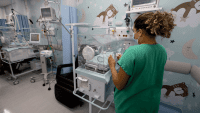As noted in Part 1 of this two-part series, interprofessional collaboration is a cornerstone of quality healthcare delivery, so it makes sense that writing produced by interprofessional teams can have a significant impact on patients. Several steps are needed, however, to ensure the project runs smoothly.
Part 1 focused on choosing coauthors and holding the kick-off meeting. Here, in Part 2, you’ll learn how to keep the writing project on track, including how to monitor progress and apply a collaborative model.
Monitor progress
Meeting goals for the writing project should include all the activities that need to occur to meet that goal: developing the idea, creating the content outline, writing the initial draft, reviewing and revising, submitting to the journal, and revising per peer review comments. Ideally, you’ve addressed these in the kick-off meeting and created a timeline. All authors should adhere to the timeline, and one person should take responsibility for monitoring progress and following up when delays occur.
Don’t feel like you’re failing if you need to adjust the timeline. Life happens. An author may have unexpectedly assumed additional job responsibilities, or another author may have a family emergency. Make needed adjustments and keep moving forward. However, also know that an author may need to bow out because of unforeseen circumstances or may need to be kindly removed from the project because of a lack of commitment.
At the start of the project, you may need to hold one or two meetings soon after the kick-off to finalize journal choice and the content outline. After that, it’s a good idea to hold periodic check-in meetings, but beware of spending more time meeting than writing.
Apply a collaboration model
Many models for interprofessional collaboration exist. These models frequently focus on individual competencies, but you also should look at overall team competencies. McLaney and colleagues developed the Sunnybrook framework of core competencies for interprofessional team collaboration. You can apply this framework to your interprofessional writing group.
The circular model, which places interprofessional collaboration at the center, has four domains: clinical and professional practice and care, education, research and quality improvement, and approach to leadership. Immediately surrounding that circle are six core competencies:
- Communication
- Interprofessional conflict resolution
- Reflection
- Role clarification
- Shared decision making
- Interprofessional values and ethics
Each competency has a definition and associated behaviors. For example, the definition for role clarification is “Interprofessional teams ensure that members understand each other’s roles, scopes, and expertise. They explore interdependencies between their roles and optimize each member’s scope with consideration of repetition and redundancies.” One of the associated behaviors is “The team creates a safe environment for all members to speak up and advocate as necessary.” (You can view the model online.)
The article describing the framework focuses on clinical application, but it’s also well-suited for a writing team. For instance, conflict resolution is a necessary competency whether caring for patients or writing a research report.
You may find it helpful to review this model at the start of the project in the context of the kick-off meeting, then refer to it as needed during the project. For example, if a conflict arises, revisit associated behaviors for conflict resolution such as “Listens open mindedly to differing opinions and ideas from diverse roles and professions.”
A rewarding experience
Writing with an effective interprofessional team can be a rewarding experience. You’ll expand your knowledge and likely gain new or deeper relationships with other team members, thereby promoting excellent patient care.


I’ve been a full-time professional nurse writer and editor for many years, and that doesn’t count the writing I did as I fulfilled my nursing roles in clinical, research, education, and management. My passion is helping nurses share their expertise through the written word, including, but not limited to, publication. Writing can be scary and intimidating. I hope to make it less so and to help you develop your writing skills the same way you’ve developed your nursing skills.
Whether you’re considering your first or your 50th publication, want to contribute to your organization’s newsletter, or crave to be a better communicator online and in print, I hope you’ll find what I write helpful. The nurse publishing colleagues I’ve learned from over the years (many of whom are contributors to my book) may not be listed by name, but I’m grateful for their willingness to share. In that spirit, I’m looking forward to sharing with you! If you have feedback, feel free to email me at csaver57@gmail.com.
References
Knapp RA, Borrego P, Atwood T. Yours, mine, ours: Some best practices for authors writing collaboratively. J Creative Library Practice. 2021. creativelibrarypractice.org/2021/11/01/yours-mine-ours/
Lingard L. Collaborative writing: Strategies and activities for writing productively together. Perspect Med Educ. 2021;10(5):163-6. doi:10.1007/s40037-021-00668-7
McLaney E, Morassaei S, Hughes L, Davies R, Campbell M, Di Prospero L. A framework for interprofessional team collaboration in a hospital setting: Advancing team competencies and behaviours. Healthc Manage Forum. 2022;35(12):112-7. doi:10.1177/08404704211063584
Saver C. Anatomy of writing. In: Saver C. Anatomy of Writing for Publication for Nurses. 4th ed. Indianapolis, IN: Sigma Theta Tau International; 2021; 3-20.
University of Washington Center for Health Sciences Interprofessional Education, Research and Practice. Interprofessional team writing toolkit. 2018. collaborate.uw.edu/programs/team-science-initiative/interprofessional-team-writing-toolkit



















